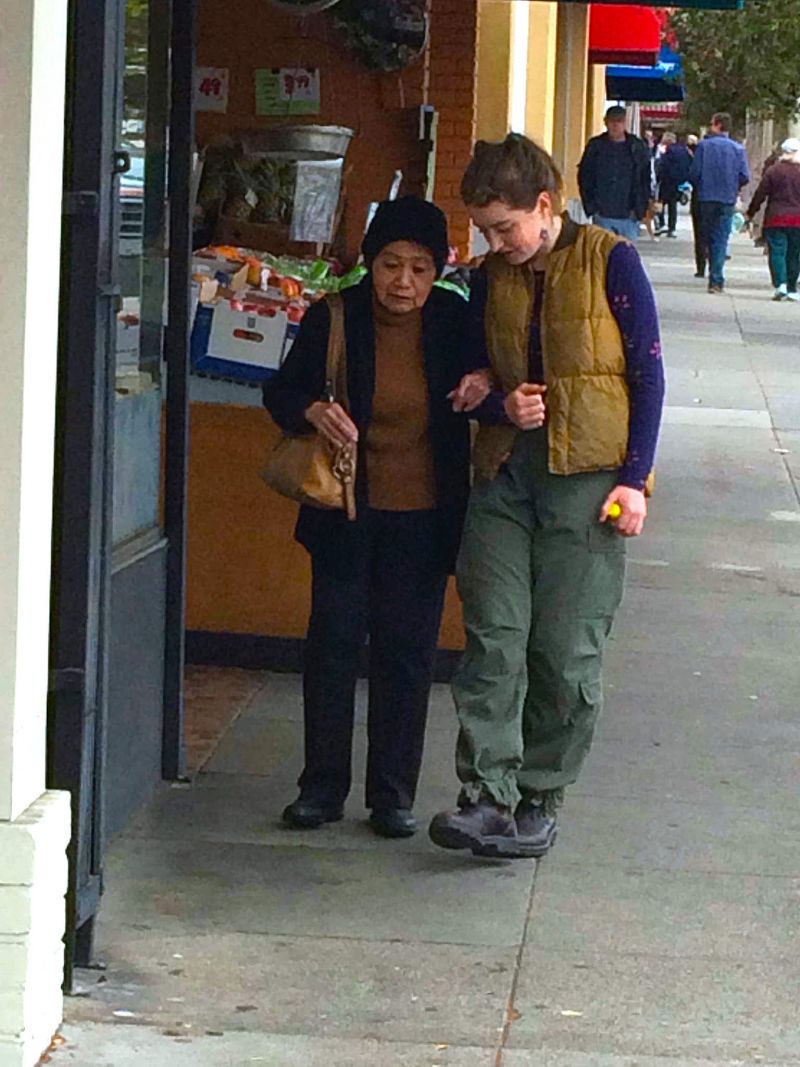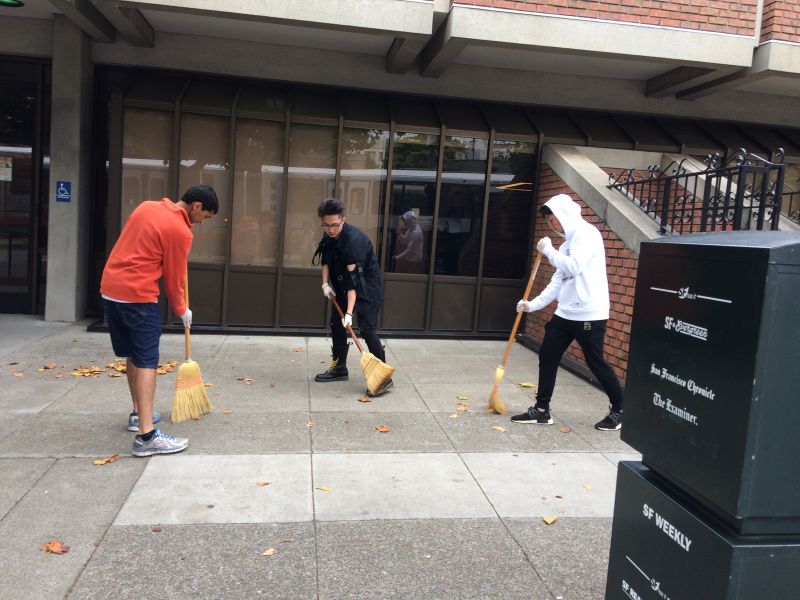Reconsidering Community Service
[Volunteer hours have been a longstanding graduation requirement at many high schools, but does it really tap into the spirit of service? SF Waldorf High recently removed the requirement, and this proposal, the basis for that decision, explains why.]
"Love is higher than opinion. If people love one another the most varied opinions can be reconciled — this is one of the most important tasks for humankind today and in the future: that we should learn to live together and understand one another. If this human fellowship is not achieved, all talk of development is empty." —Rudolf Steiner
Why do we ask the students to do community service? What is the pedagogical intention behind the request? Certainly, we are hoping to awaken our students to the world around them in a very real way that involves putting thought into action: doing something. To the degree the students devote themselves to work in the world, they begin to build capacities within their nascent ego-beings that will give meaning to their lives. We know that our students crave meaning and purpose and serving is a sure path to fulfilling that often unstated desire. The healthy social life is found only when in the mirror of each individual soul the whole community finds its reflection, and when in the community the strength of each one is living.
Somehow, our students must be part of, reflections of, the community in which we find ourselves. Together we build it within the walls of the school, and then we move outward from our center to our neighborhood. Rudolf Steiner has explained that in anthroposophical communities we can experience our first awakening to the spirit in our encounters with others, and these encounters form our greater community. It is true that we do not exist in isolation, and our students realize this, of course. The one value that every senior class has seemed to agree on when they sit together with the faculty at the end of their schooling, is the value of community. In 1986, social psychologists McMillan & Chavis formed a theory that has become the most widely accepted understanding of how communities work. Called “Sense of Community,” they describe it in one sentence:
Sense of community is a feeling that members have of belonging, a feeling that members matter to one another and to the group, and a shared faith that members’ needs will be met through their commitment to be together (McMillan, 1976).
Community flourishes through unselfish action as Steiner says in what is called “The Fundamental Social Law”:
In a community of human beings working together, the well-being of the community will be the greater, the less the individual claims for himself the proceeds of the work he has himself done; i.e., the more of these proceeds he makes over to his fellow workers, and the more his own requirements are satisfied, not out of his own work done, but out of work done by the others.
Background
The way our current Student Service Program is presented in the Student and Parent Handbook has not really changed much since the founding of the high school; it may even be better articulated now than it was in the past, with an inspiring list of goals.
From Student and Parent Handbook, 2015-2016
Service learning projects endeavor to accomplish the following goals:
- Meet community needs
- Create a collaboration between school and community
- Incorporate significant input from students
- Integrate with each student’s academic curriculum
- Create a structure that allows time to think, talk, and write about the service activity
- Foster the development of a sense of concern for others
- Include an evaluation by everyone involved: students, teachers, community agency
we stand for as a school and what our social mission might be.
[what you have experienced/witnessed of the students and ask other faculty what their experience has been.]
So much of what I wish to point out in asking us all to reconsider community service is already known to us, contained in one way or another in the above goals. It is a matter of re-enlivening the program. We need to look at it in a deeper, more developmentally-based way, in a way that is more reflective of our values as a Waldorf school.
What Is Service?
As a faculty we can start by coming to a shared agreement of what we mean by “service.” For example, the seniors read an article written by Rachel Naomi Remen entitled “Helping, Fixing, Serving.” In the article she makes the case that “service is not the same thing as helping.”
Helping is based on inequality, it’s not a relationship between equals. When we help, we may inadvertently take away more than we give, diminishing the person’s sense of self-worth and self-esteem.
Now, when I help I am very aware of my own strength, but we don’t serve with our strength, we serve with ourselves. We draw from all our experiences: our wounds serve, our limitations serve, even our darkness serves. The wholeness in us serves the wholeness in the other, and the wholeness in life. Helping incurs debt: when you help someone, they owe you. But service is mutual. When I help I have a feeling of satisfaction, but when I serve I have a feeling of gratitude. Serving is also different to fixing. We fix broken pipes, we don’t fix people.
So, fundamentally, helping, fixing, and serving are ways of seeing life. When you help, you see life as weak; when you fix, you see life as broken; and when you serve, you see life as whole.
Community Engagement Program
"My dear friends, we will only be equal to our task if we do not regard it only as a comfortable intellectual undertaking, but instead as being moral and spiritual in the most eminent sense…" —Rudolf Steiner, The Foundations of Human Experience, Lecture 1
Once we have agreed to the distinctions outlined above, knowing that our work with the students is also in the moral realm, then we need to decide what the parameters of our request of the students should be. I would like to suggest that we keep our service as local to the school as possible and certainly not outside San Francisco. The school is part of a community already, and the community is part of us. It is an economic community in the Steinerian sense: we are all meeting each other’s needs, in what can be thought of as the circulation of gifts, rather than of currency
So, the important point here is to work on the school’s relationship to its community. Relationship is one of our foundational values, the whole of our teaching is based on it. As Cristof Wiechert points out in Solving the Riddle of the Child: The Art of the Child Study, we can “invoke every conceivable shade and nuance of feeling.” He continues:
But in all cases, when I meet another person, a process of self-perception begins. How am I behaving? What unexpressed yet real feelings are living in me? How clear am I in what I’m saying? Can I be myself, or is something mingling with me that is not really me, or that I do not wish to be? (Wiechert, 2014, 20-21)
Weichert also suggests that an effect of encounters that results from the world reflecting us back to ourselves is the development of a sense of responsibility, which awakens suddenly in relation to one’s actions and “makes possible…that not only the other is changed, but above all I am myself.” (Wiechert, 2014, p. 21) He was speaking of a different context, of course, but the effects of encounter are generalizable, and certainly go to the heart of what we can regard as “moral and spiritual in the most eminent sense.” Don’t we hope for our students this awakening of a sense of responsibility and similar self-perception?
 My feeling is that we can foster this through close encounters, community relationships, the kind that endure for more than a two-week summer trip or a day at a far-flung agency. This is where the idea of local comes in. The community makes the school possible. How do we “give back” to the community? We keep it local, as a sort of reciprocity, to show gratitude. Local. If students are fortunate enough to travel to other countries to do service work, then it is extra, something to write about or to add to their college applications, but it is not service in the school’s community. We want to work starting at home, keeping it as equitable as possible, for all the students, whatever their means or opportunities.
My feeling is that we can foster this through close encounters, community relationships, the kind that endure for more than a two-week summer trip or a day at a far-flung agency. This is where the idea of local comes in. The community makes the school possible. How do we “give back” to the community? We keep it local, as a sort of reciprocity, to show gratitude. Local. If students are fortunate enough to travel to other countries to do service work, then it is extra, something to write about or to add to their college applications, but it is not service in the school’s community. We want to work starting at home, keeping it as equitable as possible, for all the students, whatever their means or opportunities.In light of all of this, I propose that we change the name of the program from Student Service Program, with its two prongs of Out of School Community Service and In-School Community Service to Community Engagement Program: Student Self-Direction and Community Self-Determination
Tapping into each student’s own sense of responsibility is another goal. Requirements are extrinsic; we want to guide the students toward work that arises from within themselves, out of true interest. So, it will be up to us to elicit that interest. One way to invite them to direct themselves, is through the writing of proposals, which are self-generated and come out of the students’ own interests and possibilities.
Proposals are the means of student self-direction. The students must think about what they can offer to the community: “this is what I plan to do this year.” We could set aside a day or part of one at the start of the year, or better yet, at the end of the year before. Ninth graders could be more carefully guided by asking them to think about what they might do when they first visit the school as the in-coming class in May. We then follow up by sending a letter about the need for a proposal with the summer mailing. (This would probably help returning students as well.) Proposals could be collaborative. This is an opportunity for student self-direction—and it’s for the community, not just for themselves.
The service work can still tie into a senior project, especially if a 12th grader has identified a need arising from work s/he has done in the past 3 years.
Review is a process that allows for community self-determination: the proposals are reviewed by the community. We organize a community review board made up of parents, student peers (Student Council? Peer educators? Elected or appointed?), maybe even people from the neighborhood, from the Merchants’ Association, or from Ardenwood. The review board has a charter that outlines how it is constructed, when and how it meets and makes determinations. Members could be elected or appointed by the community. Once approved, the students are responsible for reporting on their progress, perhaps even treating it as reporting to peers and sharing experiences. This would then create a community around community engagement with minimal management from faculty or staff. And yet, what a wonderful opportunity for faculty and staff to learn from the students what motivates them in life.
Posted by Joan Caldarera on Nov 6, 2019


